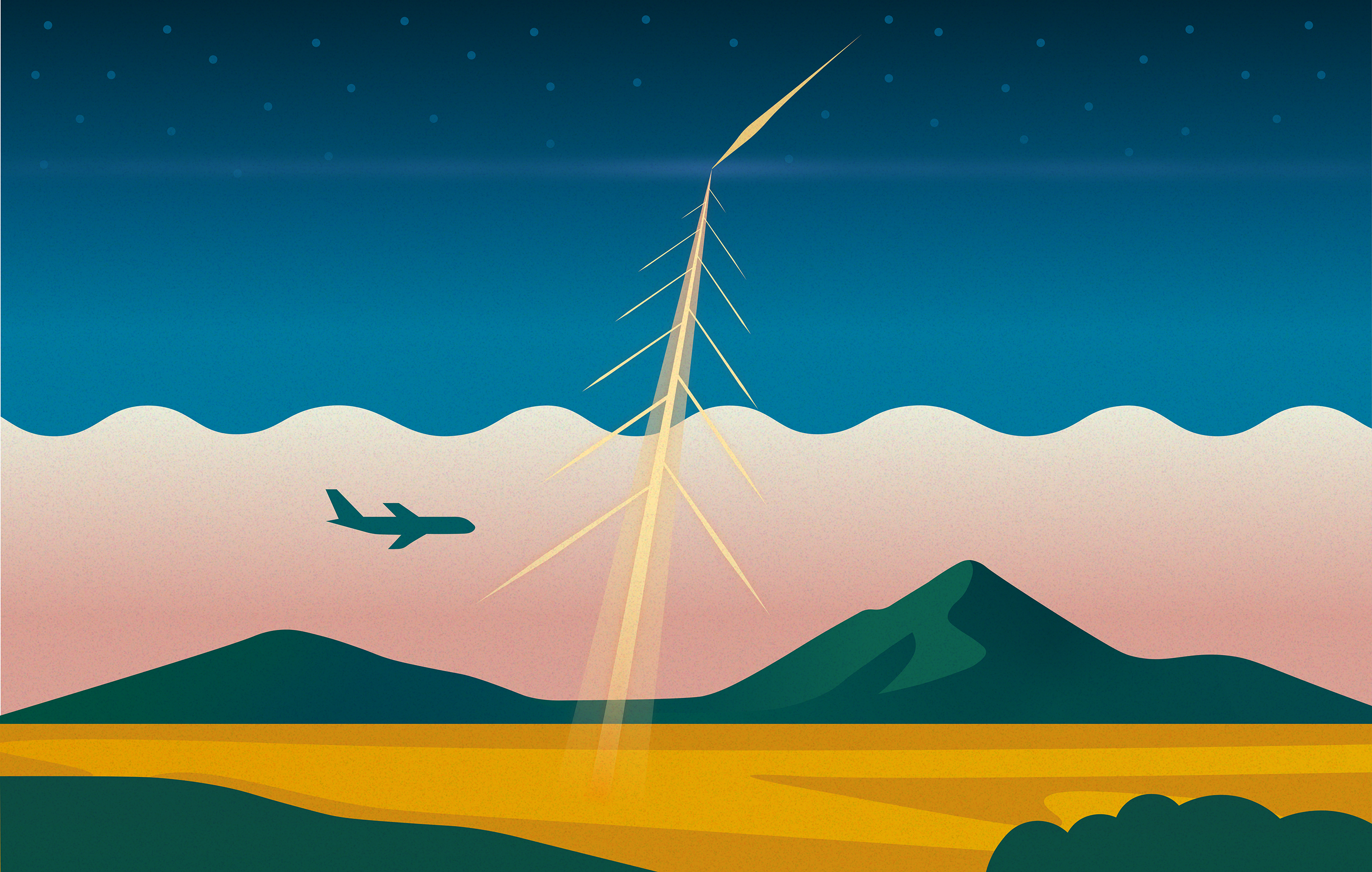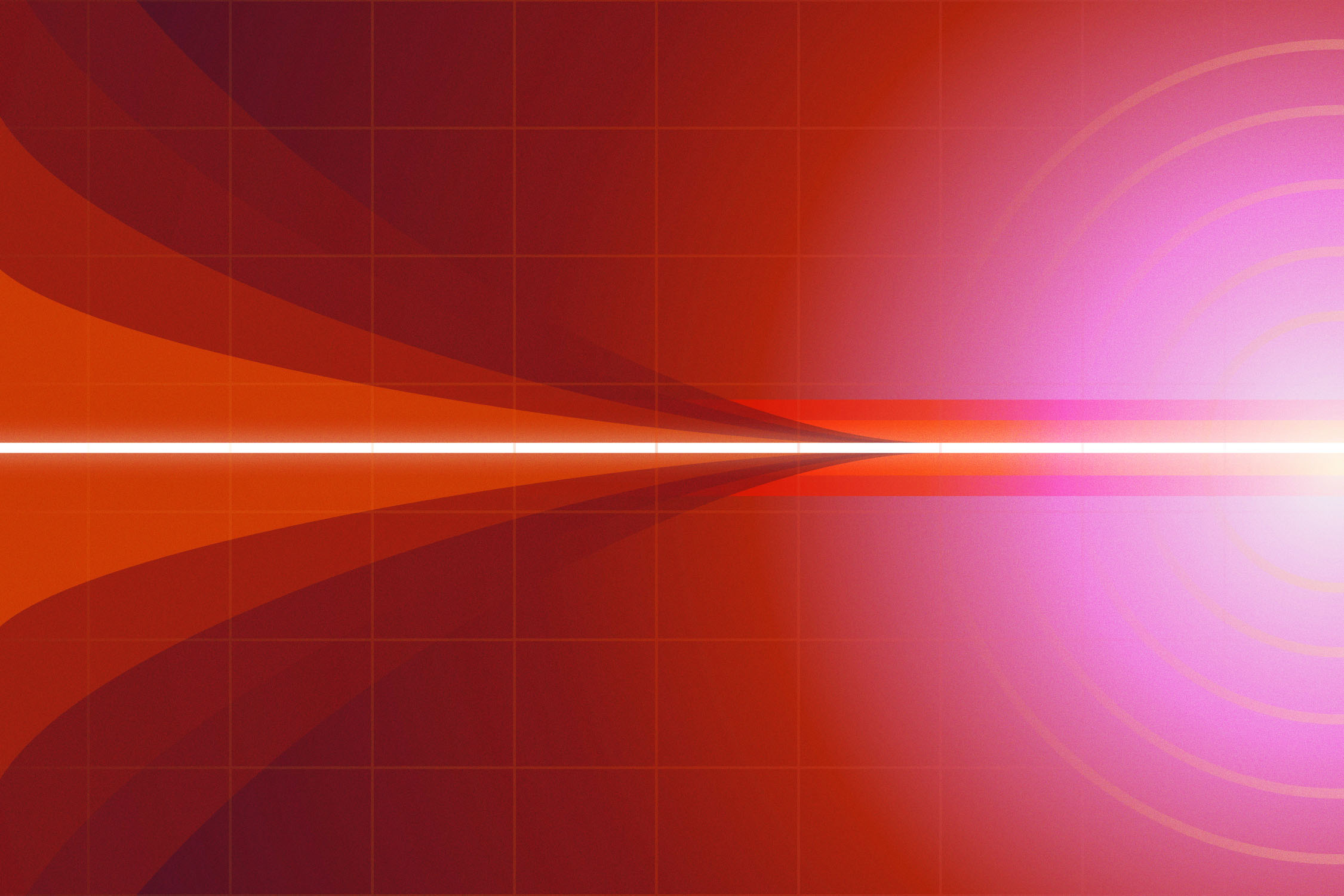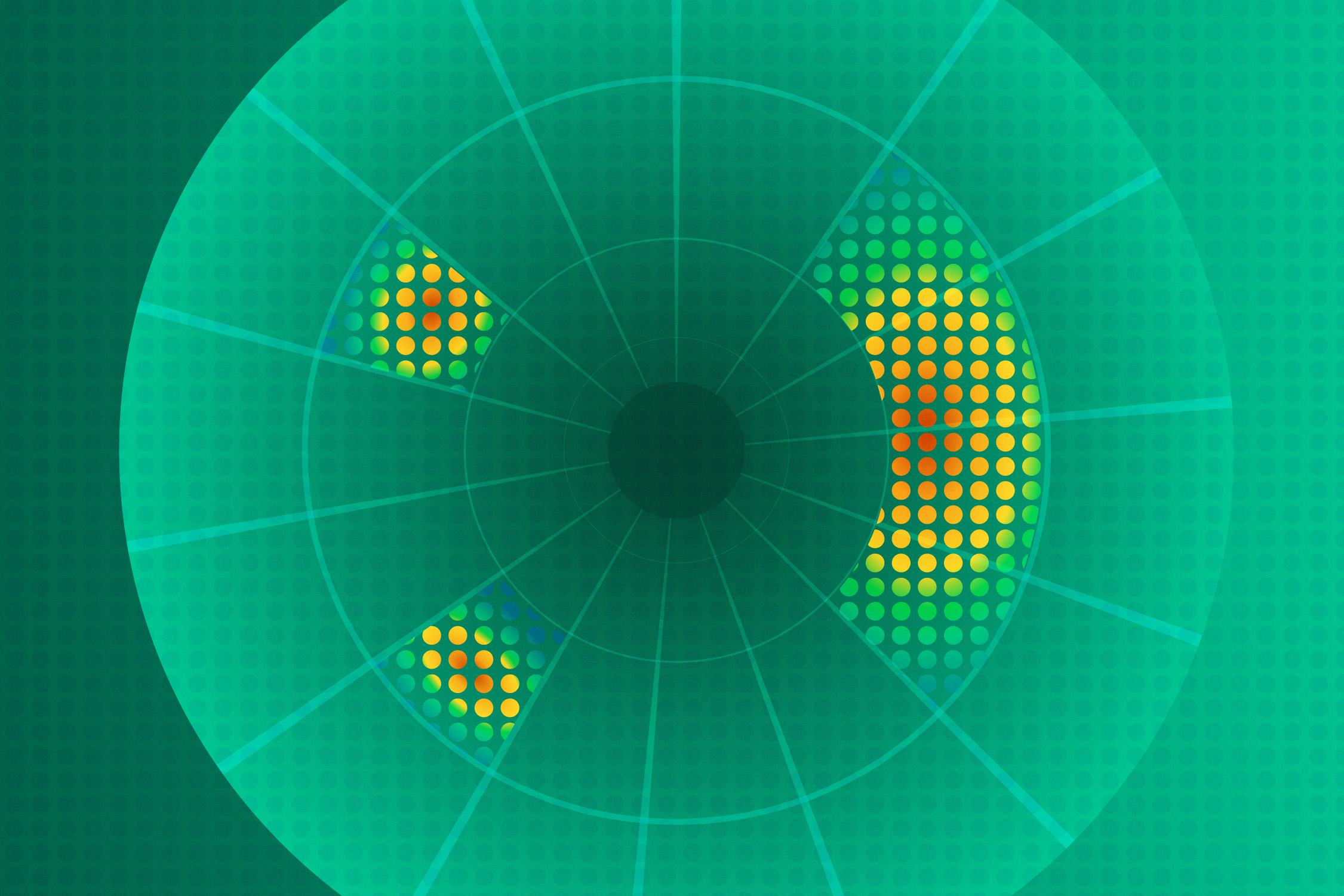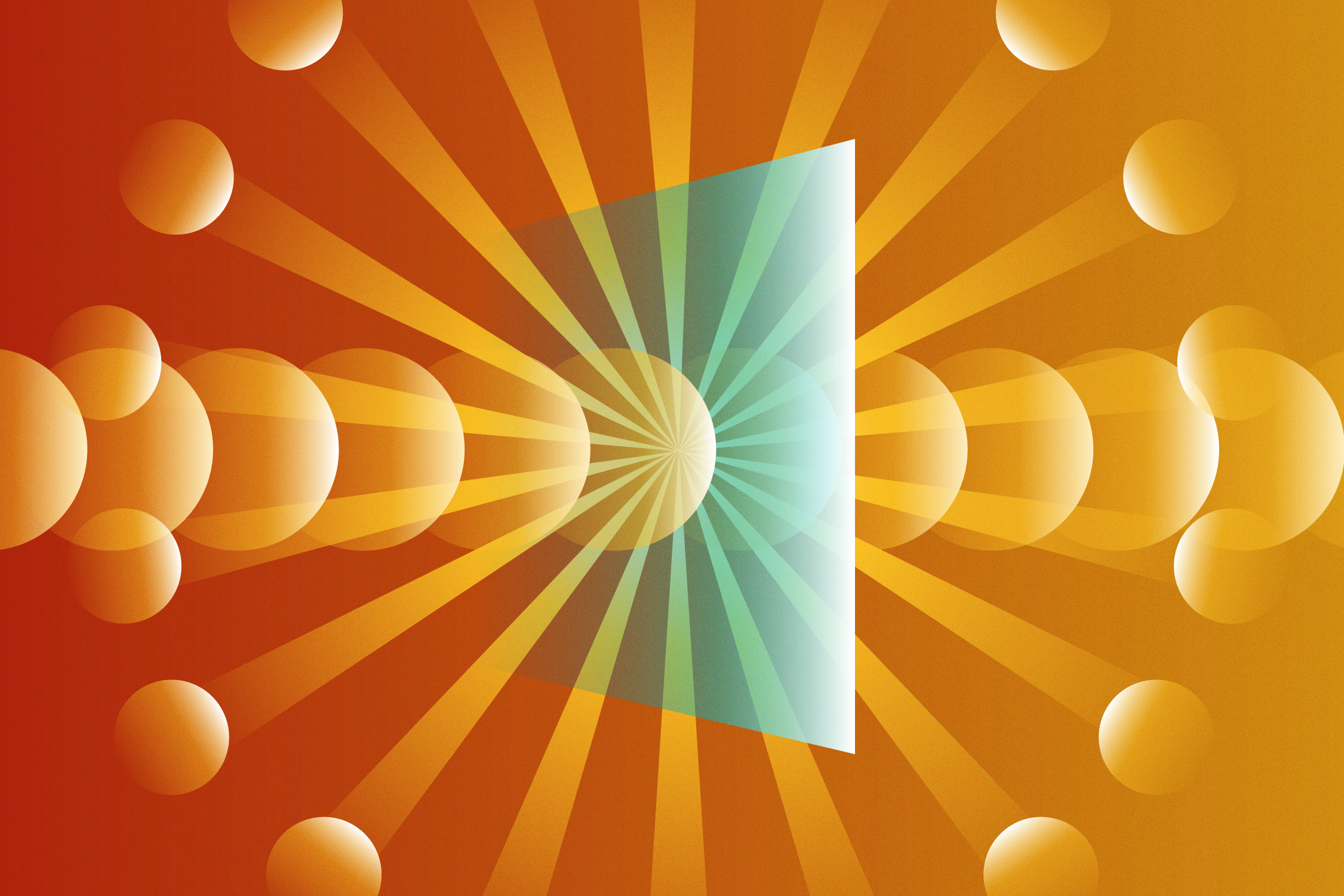pRad and the Future of Stockpile Stewardship
For more than two decades, proton radiography (pRad) has helped certify the nation’s stockpile. Now, the facility is getting a well-deserved upgrade.
- Kyle Dickman, Science Writer
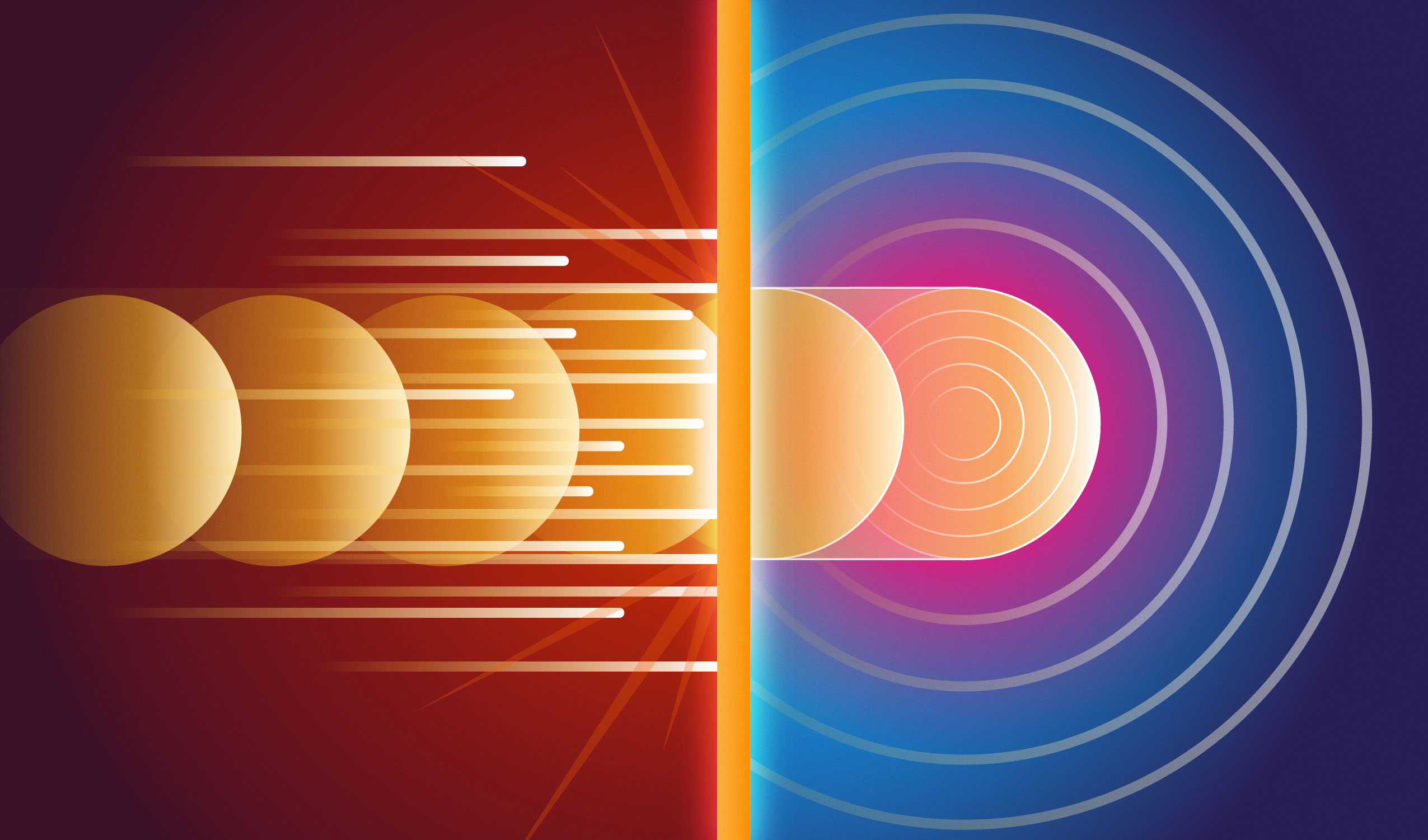
Download a print-friendly version of this article.
It’s a crisp November morning in 2023, and Eric Anderson is in the proton radiography (pRad) counting house, the control room. He’s running final checks on a crucial experiment. In minutes, a nuclear surrogate detonation, called Pagoda, will unfold in mere millionths of a second. “The detonation will be traveling at 7.3 millimeters per microsecond,” says Anderson, going over the details yet again. “The entire experiment is 100 millimeters long. So, the detonation wave is going to pass through the field of view in”—he pauses briefly—“less than seven-millionths of a second.” Syncing every piece of this dynamic experiment to billionths of a second is the difference between capturing images that validate the safety and dependability of the nation’s nuclear stockpile and capturing pictures of smoking debris. The excitement in the room is palpable.

The Los Alamos Neutron Science Center (LANSCE), home to the linear particle accelerator that’s coupled with pRad, has been down for unexpected maintenance over the past several weeks. This morning it’s up and running for only the second time this year, and pRad—a noun used both for the experimental site and the method itself—feels like a NASA control room before a rocket launch. Scientists buzz around, and inside the dome that houses pRad, technicians in white HAZMAT suits lower a small parcel of high explosives into an enormous 40-ton orb that will contain the detonation.
After 25 years and nearly 1000 experiments, pRad, as part of LANSCE, is now the focus of a multiyear signature institutional commitment that will direct funding toward modernizing these key facilities that have never been more critical to the Lab’s mission. In the wake of 1996’s Comprehensive Nuclear-Test-Ban Treaty, the U.S. was faced with the challenge of maintaining the safety and reliability of its nuclear stockpile without detonating live weapons. Experimental facilities like pRad allow scientists to conduct multitudes of targeted tests on a smaller scale. pRad uses high-energy protons passed through an explosion to capture crucial data on how materials behave under extreme conditions, and the data it creates feeds the models that ensure America’s nuclear weapons remain reliable—without the need for full-scale denotations.

Pagoda is a two-shot experimental series. Yesterday’s, essentially the control, went off smoothly. Now, after more than a year of modeling, preliminary experimentation, and prep work, Anderson’s second experiment is minutes away from detonation. Anderson, a physicist with a runner’s build and the pragmatic manner of an engineer, seems unflappable—not the type to flinch when an explosion goes off. But even he seems a bit anxious as he triple-checks the static radiographs taken moments earlier to confirm that his experiment aligns with the beamline. It does. In just a few minutes, the detonation will fire, and Anderson will finally discover if Pagoda holds the answers to a puzzle that’s vexed scientists for years: Why do detonations involving certain explosives sometimes fail?
How pRad works?
In the world that emerged after nuclear testing ceased, science and computing became the best tools for certifying America’s nuclear weapons. Without the ability to detonate weapons, certification transformed into a task of meticulous inference: prediction, surrogate experimentation, computation, and modeling. Chris Morris, a Lab physicist who invented pRad, estimates that this shift drove the Lab’s investment into supercomputers powerful enough to simulate full-scale nuclear weapons. Imaging experiments that could verify and refine models of nuclear detonations were the other half of this transformation. From America’s last nuclear test on September 23, 1992, to the new paradigm of science-based certification that emerged in the early 2000s, the Lab transitioned remarkably quickly. At the forefront of this seismic shift was Morris and pRad. “The predictive capability that came out of this was enormous,” says Morris.

Today’s nuclear enterprise depends on several primary imaging experiments distributed across various labs around the country. Los Alamos hosts two of these complementary devices: DARHT and pRad. DARHT (Dual-Axis Radiographic Hydrodynamic Test Facility) is the world’s most powerful x-ray machine. Commissioned in 2001, it uses ultra-high-powered x-rays to examine the behavior of assemblies inside weapons. However, the mean free path—basically, how far a particle can travel before it collides with something—is relatively short for x-rays, as they are easily absorbed or scattered by dense materials. Because of this, DARHT cannot provide the detailed images needed to model the first critical moments of explosions. This is pRad’s niche. By using protons, positively charged particles with longer mean free paths that can penetrate deeply in denser materials, pRad allows scientists to glimpse the very first moments of certain kinds of detonations.
Once accelerated protons enter pRad, magnetic lenses focus them to the parameters of the experiment. Upon hitting the experiment, the protons slow down. Some pass through the material undeterred. Others collide with atomic nuclei and are absorbed or deflected at extreme angles. Still others are deflected by only half a degree or so by the negative charge in the material’s electrons. Twenty meters later, the remaining protons strike a scintillator plate where their energy is converted to visible light, creating fleeting images that are captured by seven ultra-high-speed cameras. “We’re essentially measuring the intensity of the shadow,” says Morris. In the final images, the graded contrast between light and dark is created by the concentration of protons that hit the scintillator. More protons appear brighter, indicating thinner material; fewer protons appear darker, indicating denser material.
“It was the rebirth of my career,” says Morris. “Really, it was part of the rebirth of the Lab.”
“pRad is the only place where you can see not only the detonation while it’s happening inside the explosive but also the shocks going through the burning regions,” says Kathy Prestridge, who leads an experimental weapons program at the Lab. “And you can see the angles and speeds of those shocks. And you can see the densities of the explosive product. There’s a wealth of temporal and spatial information that you can’t get anywhere except pRad.”
pRad’s history
In the spring of 2023, six months before Anderson’s Pagoda experiment, Morris toured the pRad facility as he often did. Having invented pRad in the late 1990s, he had watched over the experiment with a sort of fatherly—and now, grandfatherly—care. Morris, who is in his early seventies, was by the beamline where it ran through a tunnel built for radiation shielding. It was made with concrete blocks with their weights spray-painted on them (“1950 LBS”) and steel plates repurposed from WWII battleships. About a kilometer away was the giant Cockcroft-Walton generator, the heart of LANSCE, where up to 800 kilowatts of energy—enough to power 800 homes for a day—begins its journey to pRad.

After passing through two accelerators, 300 million protons, accelerated to just below light speed, reached the fork in the main beamline where Morris stood wearing a brimmed cap adorned with a turkey feather. He gestured to the right fork, which led to the ultra-cold neutron facility, and then to the left, which went to the pRad dome. Two decades ago, this fork in the road was pRad’s temporary home. “The Lab, it’s safe to say, hadn’t planned for the cessation of testing,” he said. “This is where we proved the experiment’s value to the whole enterprise.”
Back in the winter of 1996, when proton radiography at the Lab was just a seed of an idea, the Lab was, as Morris put it, “in fibrillations.” That year, President Clinton had signed a new international treaty ending nuclear testing, the method the Lab had relied on for the past 40 years to fulfill its mission of certifying the stockpile’s safety and reliability. The Lab now faced severe funding cuts and began laying off personnel, scrambling to adapt to the new reality. However, the paradigm shift also created an urgent need to develop new methods to guarantee the 11,000-plus weapons in America’s stockpile at the time. (There are fewer today.) “When testing ended, stockpile certification became reliant on modeling and even more reliant on the data we were putting into those models. We needed both focused and integrated experiments,” says Shea Mosby of the Accelerator Strategy Office.
At the time, DARHT was being promoted as the tool the Lab needed for imaging detonations. Morris agreed with its potential, but he also recognized a limitation: scattered x-rays could blur images of explosions. But maybe protons could do what high-energy x-rays couldn’t. To test the idea, his team set to work developing a proton imaging device. They borrowed a quadrupole magnetic lens, a hulking piece of metal that would focus the accelerator’s proton beam, from a LANSCE beamline being used for cancer research, and got another legacy magnet from Lawrence Berkeley National Laboratory still bearing the label “Atomic Energy Commission” from the late 1940s. They found a “tiny” 3-square-foot vessel, plumbed it into the beamline, and borrowed a high-speed camera initially intended to photograph the last canceled full-scale nuclear weapons test. The first images pRad produced were of an iron plate with “pRad” etched into it.
Why do detonations involving insensitive explosives sometimes fail?
Soon after, a program director from the Weapons division summoned Morris to his office. “I was expecting him to hand me a pink slip,” said Morris, who believed at the time that he was about to be laid off. Instead, the director asked if pRad could help certify the country’s nuclear stockpile. Morris left the meeting with a million-dollar budget and a mission to turn pRad into a dynamic imaging experiment. “It was the rebirth of my career,” Morris said.
With funding secured, Morris began to develop a proof-of-concept pRad experiment at Brookhaven National Laboratory’s accelerator, 30 times more powerful than the one at LANSCE. Within a year, the team achieved a seminal result on the French Test Object, a standardized test for grading imaging devices that features a sphere layered with different materials including a hollow core surrounded by tungsten, copper, and foam. The results revealed pRad’s full potential. “With protons, unlike with x-rays, we could see straight into the void in the middle of it, with every layer well resolved,” Morris said.

Their first major dynamic experiment at the Lab, in 2001, was designed—like Anderson’s Pagoda shot decades later—to help explain why certain explosives weren’t detonating properly. Because their lone camera could capture only one image of each explosion, Morris and his team had to fabricate several experiments as close to identical as possible. They detonated each experiment, capturing a single image timed to the 600-microsecond proton pulse from each explosion. For example, one image from the first detonation showed the explosion’s beginning, the next detonation showed the middle, and the last showed the end. To ensure proper alignment of each shot, a technician had to climb into the vessel to make minuscule adjustments by hand. “It’d take a whole day to get one image,” says Morris. The final series of images was groundbreaking. They showed detonation waves failing to propagate around a corner of the explosives. The modelers had data like they’d never had before.
By the end of 2003, pRad had become a Lab fixture. However, elucidating the exact physics of certain kinds of detonation failures would take a couple more decades.
Building experiments for pRad
Not long after Morris’s regular check at pRad, Eric Anderson was getting ready for the final stages of the Pagoda experiment. It was an April morning, and he drove his Chevy 2500—outfitted with a lightbar and a “High Explosives” placard—toward the Lab’s prep area. As he passed through the gate, armed guards in fatigues waved him through. On one side, a concrete pad used for Manhattan Project tests; on the other, a meadow where elk often roam. Parking by the first of eight concrete bunkers buried beneath tons of dirt, he heard the faint sound of Weezer’s “Buddy Holly” coming from behind seven heavy doors. “It’s not a bomb factory,” he joked. “It’s called a prep room.”

Anderson’s research focuses on detonation failure. Detonations are chemical reactions coupled with a shockwave that compresses and heats the material out ahead of it, causing it to combust. Since the late 1970s, scientists have known that in certain shapes of explosives, detonation waves sometimes fizzle out. The shockwaves slow down, reducing the amount of energy being transferred to the explosives until the detonation fails. Morris had noticed this failure during his pRad experiments in the early 2000s, but those experiments used complex conical shapes that affected how the shockwave and chemical reaction interacted. Anderson aimed to more precisely isolate the physics behind detonation failure.
After months of collaboration with modelers, Anderson’s team designed the simplest geometry for their explosive tests: a cylinder. That morning in the bunker, two technicians—the types of careful people who make the Lab go round—were bent over the prep room’s workshop tables, gluing 11 hair-width copper wires to two sticks of explosives the dimensions of new pencils. These wires would measure detonation velocity and wave shape.
The first stick, a control, maintained a consistent diameter of 8.0 millimeters (mm), allowing the detonation wave to sustain itself. The second stick stepped down from 8.0 to 7.9 mm, a point where the detonation was known to fail. By comparing the two, Anderson hoped to observe the physics behind the shockwave decoupling from the chemical reaction, causing the detonation failure. “If you want to be able to accurately predict failure where you can see the shape of the wave, the timing of the wave, and all of those things, this really allows you to compare your theory and model to your experiments,” Anderson said. The trick now was figuring out precisely when to create images that would show the full evolution of the detonation failure. That required a tuning experiment before going to pRad.
pRad has never been more critical to the Lab’s mission.
The two Pagoda explosive sticks being built that morning were bound for an experimental site called Chamber 8, or the pRad “prep school,” as Anderson’s team called it. At Chamber 8, the sticks would be detonated in a containment vessel and photographed by a camera that shoots 16 frames over 7 millionths of a second. These images would show a step-by-step progression of the detonation, but they couldn’t penetrate the debris and water vapor to reveal the actual detonation wave. Because the sticks were exact replicas of those that would ultimately be used in pRad, Chamber 8’s images helped Anderson select, down to the millionths of a second, the exact timing for the radiographs from pRad that would be most revealing.
“The work we’re doing at Chamber 8 justifies the use of pRad,” said Mark Short, one of the explosives modelers who worked closely with Anderson to design Pagoda. Using it by itself to create models would be like trying to understand the shape of a river bottom by studying the surface waves alone. In this analogy, Chamber 8 reveals where the waves are, while pRad shows the river bottom that creates them. “To model the physics, you need to capture the changing density gradients and how waves move differently through different material densities,” Short said.
To model a detonation failure, Anderson and Short needed to observe the detonation failure, and once they had their timing right, the only place to do that was pRad.

pRad's future
Major changes are now afoot at pRad and LANSCE. After a 20-year hiatus, plutonium experiments will return to pRad next fall, making it one of only two places in the country where small-scale plutonium experiments can be detonated. “We absolutely need to do more experiments of that nature,” says Prestridge. “If we do not do the experiments, or we do them at too slow of a cadence, we will not have the ground truth that we need to understand what the codes are doing.” This urgency influenced the Lab’s decision to prioritize upgrading LANSCE, and by extension, pRad. Keeping pace with evolving nuclear physics demands faster, more reliable data—something only pRad can contribute.
One reason behind the delay that held up Anderson’s Pagoda shot were troublesome parts called klystrons, high-power radiofrequency tubes used to generate the power signal for the accelerator structures. “These vacuum tubes are charged with and then dump around 55 megawatts 120 times a second. That’s a lot of power in them at once,” says Mosby, of the Accelerator Strategy Office, adding unceremoniously, “They’re old, and they break.” This is happening more frequently, with hardware failures trending up and the availability of replacements for aging parts trending down. “There’s a significant decline in the manufacturing base to buy pieces, critical for us, that were state-of-the-art in 1972,” says Mosby. “In addition, the newly manufactured components have significantly less reliability than the old parts. Evidently, the old adage that ‘we don’t build things like we used to’ is true here.”

If all goes according to plan, the LANSCE Modernization Project (LAMP) will begin this fall. LAMP will modernize the outdated parts in the accelerator’s front end, replacing the 60-year-old Cockcroft-Walton generator and the drift tubes through which the protons are accelerated. These efforts will benefit all experimental areas that rely on LANSCE. While this work is underway, efforts to replace the aging klystrons will also begin. It could take 10 years, but once the upgrade is complete, pRad will be able to field nearly twice the experiments it does today. The change can’t come soon enough. “Once we get this plutonium capability up and running, scientists are going to come running to use the facility,” Prestridge says.
For now, though, beam time is being allocated to critical experiments on the docket, like Anderson’s. By 10:45 a.m., the second Pagoda shot—the one that steps down from 8.0 to 7.9 mm—is ready. The dome is cleared, and inside the counting house, all eyes are on the monitors.
“Sam, send me another pulse,” says Levi Neukirch, today’s Experimenter in Charge. Some 300 million protons come coursing down the accelerator at 84 percent of the speed of light, triggering a device that detonates the experiment in the vessel.
Hundredths of a microsecond later, Anderson’s engineered phenomenon takes shape. At 7–8 kilometers per second, the detonation wave consumes the explosive stick, sweeping past the transition where it steps down from 8.0 to 7.9 mm. There, the wave starts to weaken and slow as the detonation begins to fail. As pulse after pulse of 300 million protons stream through the containment vessel, the detonation front begins to do what sustainable detonations don’t; it changes. As the shockwave accelerates down the explosive stick, the center of the detonation wave expands faster than along the edges, so the wave bows into a shape that Anderson will later describe as a “meniscus or a contact lens.” Were the Pagoda experiments longer, the shockwave would eventually completely decouple from the chemical reaction propelling it, causing the detonation to stop completely.
At almost the same moment that Neukirch calls for the pulse, a clang—like a screwdriver being dropped inside a barrel—reverberates around the counting house, marking the experiment’s conclusion long after it has actually ended. A technician raises his arms in celebration.

Neither Anderson nor Short seem particularly excitable, but both give faint smiles and, like patient kids finally opening their Christmas presents, head to the monitor to see the final raw images from Pagoda. To the untrained eye, the images look almost identical to those from the previous day’s shot, which showed the detonation wave propagating smoothly through the 8.0 mm stick of explosives. At the monitors, Anderson and Short immediately spot the slight bend in the detonation front—evidence to them that Pagoda delivered all that it promised. “That’s what we wanted,” says Short. “We’re getting insights into the mechanism of failure.” This breakthrough could reshape how scientists model detonation failure in future experiments. By uncovering previously unseen dynamics in how shockwaves propagate, the Pagoda results will improve the accuracy of the models used to predict the performance of nuclear weapons, ultimately leading to a stockpile that’s better understood, more reliable, and safer.
There’s a lot of temporal and spatial information that you can’t get anywhere except for pRad
Morris, who has come to watch, as he has for almost all of the 1000 experiments at pRad, pauses his work at a computer in the counting house to note the younger scientists’ appreciation. Then he sinks back into his chair to examine data on new materials for scintillator plates. He’s searching for one that would allow pRad to produce even faster images of detonations because the facility that has defined his career and helped shape the Lab’s current identity must keep evolving to meet the challenges of stewarding tomorrow’s stockpile. pRad’s got decades more work to do.
People Also Ask
- What is Proton Radiography (pRad)? Proton radiography is a high-resolution imaging technique that uses high-energy protons to visualize how materials behave under extreme conditions. Developed at Los Alamos National Laboratory, proton radiography (or pRad) allows scientists to peer inside dense objects during high-speed events, capturing data that traditional x-rays can't. This technique plays a critical role in stockpile stewardship, enabling researchers to collect data that is used to verify the safety and reliability of nuclear weapons without live nuclear testing. By tracking how protons are absorbed or deflected as they pass through an experiment, scientists can precisely measure density, shockwave behavior, and detonation dynamics.
- What is dynamic imaging and what is it used for? Dynamic imaging refers to high-speed visualization techniques that are used to capture data from rapid, fleeting events—such as explosions, shockwaves, or material deformation. Unlike static imaging, which captures a single moment, dynamic imaging records how systems evolve over microseconds or even nanoseconds. At research institutions like Los Alamos National Laboratory, dynamic imaging is essential for studying the physics of detonations, validating simulations, and supporting stockpile stewardship.
This online article has been updated from the print edition.

